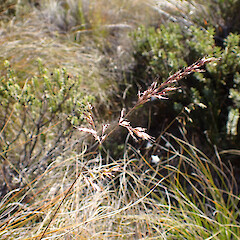Trisetum serpentinum
Synonyms
None
Family
Poaceae
Flora category
Vascular – Native
Endemic taxon
Yes
Endemic genus
No
Endemic family
No
Structural class
Grasses
Chromosome number
2n = 28
Current conservation status
The conservation status of all known New Zealand vascular plant taxa at the rank of species and below were reassessed in 2017 using the New Zealand Threat Classification System (NZTCS) – more information about this can be found on the NZTCS website. This report includes a statistical summary and brief notes on changes since 2012 and replaces all previous NZTCS lists for vascular plants.
Please note, threat classifications are often suggested by authors when publications fall between NZTCS assessment periods – an interim threat classification status has not been assessed by the NZTCS panel.
- Conservation status of New Zealand indigenous vascular plants, 2017 . 2018. Peter J. de Lange, Jeremy R. Rolfe, John W. Barkla, Shannel P. Courtney, Paul D. Champion, Leon R. Perrie, Sarah M. Beadel, Kerry A. Ford, Ilse Breitwieser, Ines Schönberger, Rowan Hindmarsh-Walls, Peter B. Heenan and Kate Ladley. Department of Conservation. Source: NZTCS and licensed by DOC for reuse under the Creative Commons Attribution 4.0 International licence.
2017 | At Risk – Naturally Uncommon | Qualifiers: RR, Sp
Previous conservation statuses
2012 | At Risk – Naturally Uncommon | Qualifiers: RR, Sp
2009 | At Risk – Naturally Uncommon
2004 | Range Restricted
Distribution
Endemic. North and South Islands only. In the North Island known only from the Surville Cliffs, North Cape. In the South Island confined to the ultramafic mineral belt of DUrville Island, Mt Dun, and the Red Hills.
Habitat
Confined to Ultramafic soils and rock exposures where it usually grows on open ground or mixed in with other short grasses. Occasionally on cliff faces.
Detailed description
Dark green, red-green to red, diffuse, tufted grass up to 800 mm tall. Leaves narrow, inrolled, overtopped by narrow to somewhat lax, purplish to maroon panicles. branching extravaginal. Leaf-sheath 10–40 mm, softly pubescent, with longer scattered hairs on sheaths of culm-leaves, often also on margins. Ligule 0.4–0.8 mm, erose, minutely ciliate. Leaf-blade 20–160 mm, inrolled, rarely not, < 1 mm diameter, up to 2 mm wide, often with scattered long hairs, undersides smooth or with fine prickle-teeth on ribs; margins minutely prickle-toothed, often with scattered long hairs. Culm 80–460 mm long, slender, internodes with long fine hairs above nodes, and with a small band of shorter hairs below nodes, uppermost node consistently glabrous. Panicle 20–100 × 5–20 mm, narrow-lanceolate to elliptic, sometimes open, with visible rachis and short ascending to spreading branches bearing clustered spikelets; rachises and branches with moderately dense, fine prickle-teeth and often a few longer hairs at lower nodes of rachis and at base of panicle. Spikelets 4–6.5 mm, purple or maroon. Glumes unequal, with sparse short prickle-teeth on keel; lower ⅔–¾ length of upper, oblong-lanceolate, upper < to more or less equivalent in length of spikelet, elliptic-lanceolate; margins with very few minute prickle-teeth near acute to acuminate apex. Lemma 3.0-4.5 mm, bicuspid, minutely-papillose; awn 3–4 mm, usually recurved, insertion point in upper quarter of lemma. Palea minutely prickle-toothed on keels and margins. Callus hairs 0.2 mm. Rachilla hairs to 0.8 mm. Lodicules to 1 mm, glabrous. Anthers to 1.5 mm long. Ovary to 0.8 mm; stigma-styles to 1 mm. Seed not seen.
Manaaki Whenua Online Interactive Key
Similar taxa
Closest to T. lasiorhachis (Hack.) Edgar with which it shares distinctly hairy culms and leaves. However, as the name implies T. serpentinum is endemic to ultramafic substrates. A habitat from which T. lasiorhachis is absent. Trisetum serpentinum is characteristically reddish-green, T. lasiorhachis green to grey-green. In T. serpentinum the lemma is 3.0–4.5 mm long, the awns ≤ the lemma; the leaf-blade inrolled, < 1 mm diameter, only very rarely flat and up to 2 mm wide. In T. lasiorhachis the lemma is 5.0–7.5 mm long; the awn is much greater than of equal to the lemma; the leaf-blade is usually flat (rarely inrolled), and 1.3–3.3 mm wide. Trisetum serpentinum is known from the North and South Islands, T. lasiorhachis only from the North Island.
Flowering
October–February
Fruiting
December–May
Propagation technique
Easy from fresh seed and rooted pieces but difficult to maintain in cultivation. Does best in a pot.
Threats
Not directly threatened, however, it is confined to ultramafic rock and soils, and in some of these locations it can be very uncommon.
Etymology
trisetum: Three-bristled
serpentinum: Refers to a snake
Where To Buy
Not commercially available
Attribution
Description modified from Edgar and Connor (2000).
References and further reading
Edgar E, Connor HE. 2000. Flora of New Zealand. Vol. V. Grasses. Manaaki Whenua Press, Christchurch, NZ. 650 p.
















